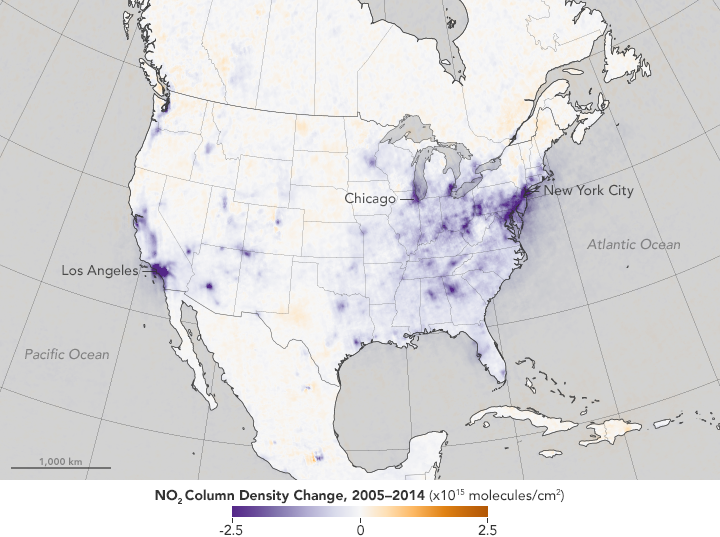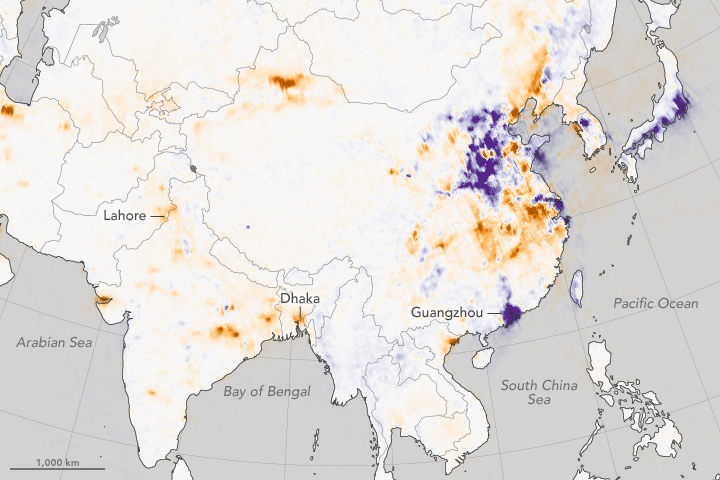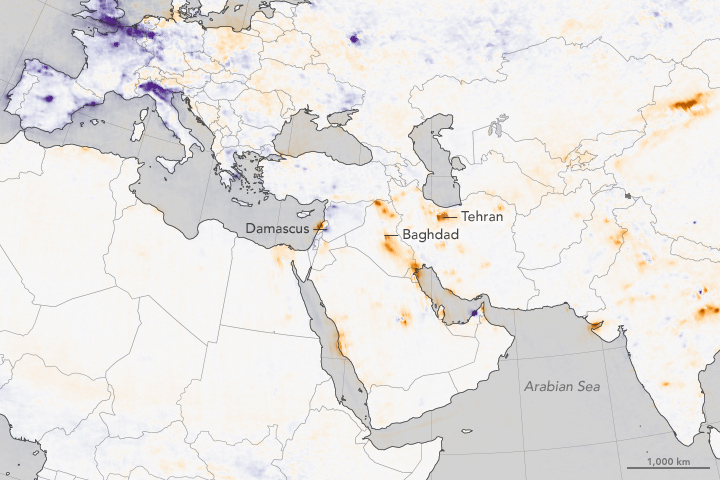


In July 2004, a Delta II rocket propelled an unmanned spacecraft named Aura into orbit to study air pollution, among other things. More than a decade after that launch, the spacecraft’s Ozone Monitoring Instrument (OMI) has observed significant changes in a key pollutant: nitrogen dioxide (NO2), a noxious gas emitted by motor vehicles, power plants, and industrial facilities.
The details vary by region, country, and city. The maps on this page are based on data collected by the Dutch-Finnish Ozone Monitoring Instrument between 2005 and 2014. Increases in nitrogen dioxide levels are shown in orange; decreases are shown in blue.
In urban areas of the United States, levels of NO2 fell, mainly because of environmental regulations that reduced emissions from motor vehicles and power plants. Declines are most evident in the eastern United States, though densely populated western cities such as Los Angeles (56 percent), Phoenix (54 percent), Atlanta (48 percent), New York (45 percent) also saw levels drop significantly. NO2 concentrations increased slightly in the Williston Basin (North Dakota), the Permian Basin (west Texas), and the Eagle Ford Shale (southern Texas)—areas where natural gas and oil production has increased dramatically due to horizontal drilling and high-volume hydraulic fracturing.
Aura observed declining NO2 levels over most European cities, likely due to the tightening of vehicle emission standards. The cites in Europe that experienced the largest decreases were Madrid (48 percent), Lisbon (47 percent), and Barcelona (44 percent).
“These changes in air quality are not random,” said Bryan Duncan, an atmospheric scientist at NASA’s Goddard Space Flight Center. “When governments step in and say ‘we’re going to build something here’ or ‘we’re going to regulate this pollutant,’ you see the impact in the data.” Duncan and colleagues detailed their findings in January 2016 in the Journal of Geophysical Research: Atmospheres.

In China, levels of nitrogen dioxide rose sharply over some cities and dropped over others. Cities in the North Central Plain saw the biggest increases; meanwhile, nitrogen dioxide was down in Shanghai (30 percent), Hong Kong (28 percent), Quangzhou (43 percent), and even Beijing (10 percent) due to environmental regulations. Beijing’s 10 percent decrease is particularly remarkable given the extent of urbanization that has occurred in recent years, note Duncan and his coauthors.
Meanwhile, rising levels of nitrogen dioxide were observed in many cities in India. Chennai, Bengaluru, and Kolkata all saw increases of 20 percent or more. In Pakistan, levels of the pollutant went up 52 percent in Lahore and 46 percent in Islamabad. In Dhaka, the capital city of Bangladesh, NO2 increased by 79 percent, more than any other city in the world.

The story in the Middle East was mixed. In Iraq, NO2 levels rose 67 percent in Baghdad, 44 percent in Mosul, and 59 percent in Kirkuk. In Iran, Tehran saw levels rise 25 percent. In contrast, the pollutant decreased significantly in Syria, a country that has been plagued by war since 2011. Nitrogen dioxide has dropped 37 percent in Damascus and 40 percent in Aleppo.
NASA Earth Observatory maps by Jesse Allen, using data provided courtesy of the Aura OMI science team. OMI was developed through a partnership between NASA and the Dutch and Finnish meteorological institutes and space agencies. By Adam Voiland, with information from Ellen Gray.